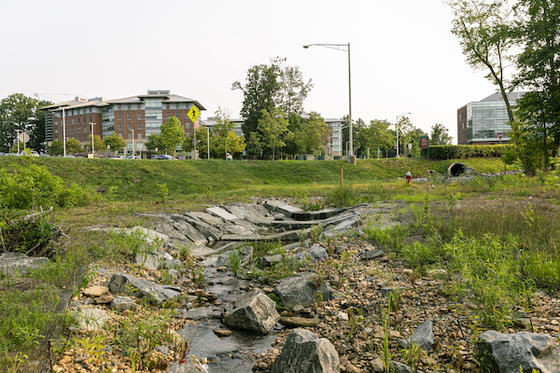In This Story
Many people at George Mason University do not realize that Mason Pond is actually there for stormwater management.
That bit of news was delivered by Mason researcher Jennifer Sklarew during her talk at the recent Head Above the Water event in Washington, D.C.
Planned by Mason Exhibitions in the School of Art, with collaborators including the DC Department of Energy and Environment, City as Living Laboratory, local artists, and guest speakers, Head Above the Water included a walk along D.C.’s Watts Branch and Oxon Run streams to raise awareness about flooding in those neighborhoods and the flood mitigation programs available to residents.

Mason is deeply committed to pioneering processes that can answer the grand challenges of water, its responsible management, and sustainability. In fact, the university’s interdisciplinary approach and cutting-edge research as part of its strategic direction, has turned Mason’s campuses into a Living Lab.
Take what Sklarew, an assistant professor in Mason’s Department of Environmental Science and Policy, said about Mason Pond.
“The stormwater channels that look like streams are components of the actual stormwater system,” she said. “The pipes outflow into those streams, and then everything goes into the pond.”
But that is just the tip of the iceberg when it comes to what Mason is doing and accomplishing when it comes to handling water resources on its campuses, using research and technologies that can be applied beyond to the broader community.
At Mason Square, Mason Innovation Partners encountered a serious infrastructure issue that posed a frequent stormwater challenge for the surrounding area of the new Fuse at Mason Square in the heart of Arlington’s Rosslyn-Ballston corridor.
Replacing the culvert required precise coordination with the future building foundation design and intricate sequencing to control the constant flow of stormwater as it was diverted from the old culvert pipes to a new 12 feet wide, 6 feet high box culvert.
Facilities also has an extensive list of mitigation protocols it applies to remove pollutants and control storm runoff flow rates, including Illicit discharge detection and elimination, and construction site runoff control.
Mason’s stormwater system is monitored by Facilities, which can prohibit projects that might interfere with the system. The university recently completed a stream restoration project on the Fairfax Campus that not only improved the flow of the waterways but added asphalt sidewalks and some lighting so the campus community can enjoy the paths.

Also on the Fairfax Campus, the irrigation system has sensors that register rainfall to control landscape watering. The irrigation system on the Science and Technology Campus evaluates local weather data. Additionally, the campus strives to create more vegetated regions, with green roofs, vegetated gardens and swales. There are also plans to design additional dry and wet retention ponds to reduce stormwater runoff and pollution in our waterways.
Celso Ferreira, an associate professor in Mason’s Sid and Reva Dewberry Department of Civil, Environmental, and Infrastructure Engineering, calls the approach engineering with nature—taking advantage of what nature already provides and using it efficiently in engineering.
“How can we use nature in a way that benefits society for flood protection other than being detrimental to causing more floods,” said Ferreira, who also heads Mason’s Flood Hazards Research Lab, a collaboration between multiple Mason colleges and the university’s Institute for Sustainable Earth. “We’re trying to investigate natural features that can help us in engineering design that we can use to smartly prevent flooding.”
Ferreira also co-directs the Virginia Climate Center, which works with local communities across the commonwealth to support climate resilience, action, and planning for communities. Ferreira said he tries to bring those concepts into the classroom “to make sure that the future engineering workforce that we’re graduating design and implement infrastructure in a way that they’re mindful of natural processes. Then we can use them smartly to prevent flooding.”
For Sklarew, the Head Above the Water event was a natural extension of the outreach work she does as a Mason faculty member.
“I go into rural communities and talk with them about what they think their challenges are for food, energy, water, and climate, and how to develop solutions that emerge from within the community rather than outside the community,” said Sklarew, who connects her research with environmental justice. “The walk on Oxon Run and Watts Branch is a great example of something like that.”
